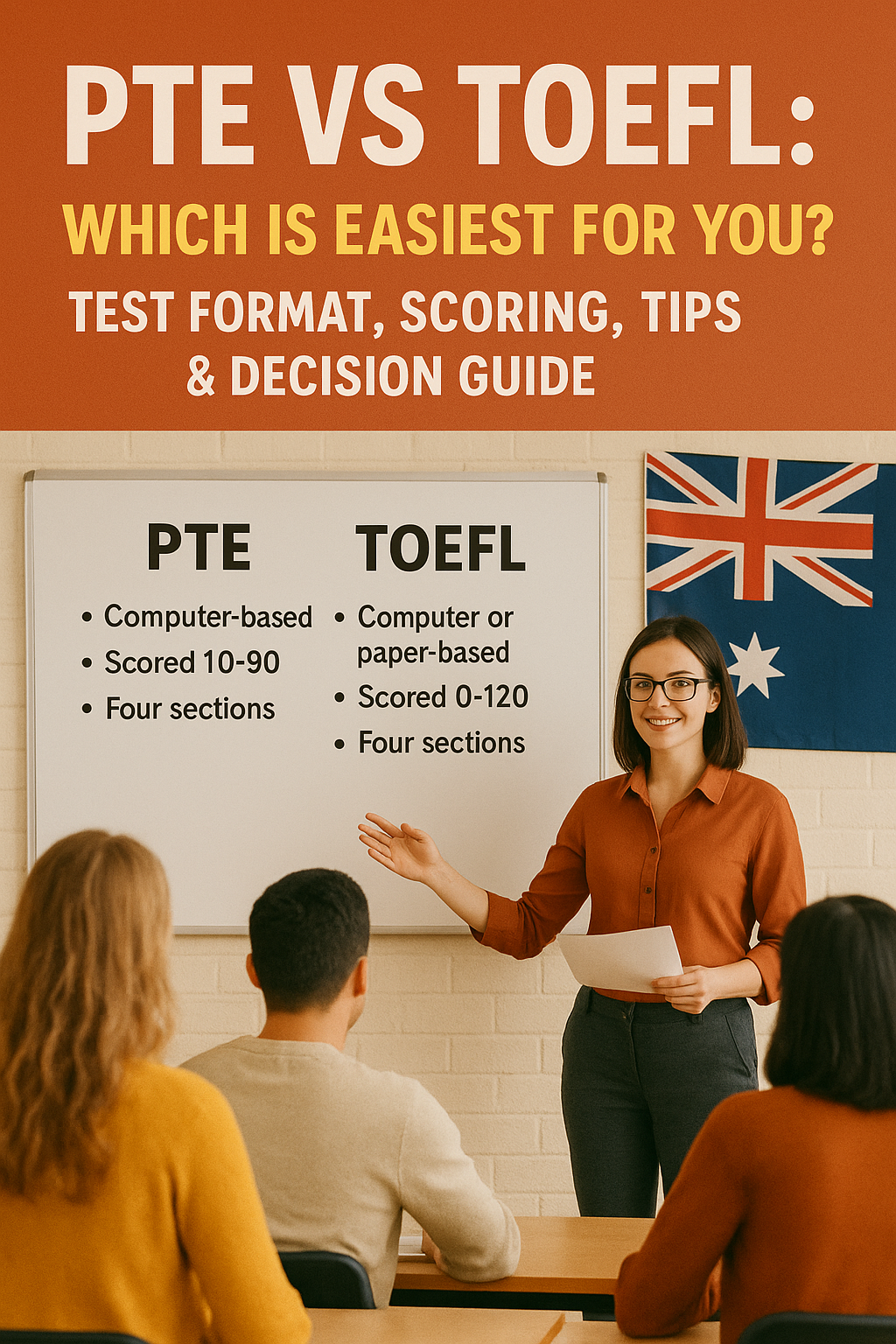Confused between PTE and TOEFL? This guide compares formats, difficulty, scoring, and tips—so you can choose the easiest English test for your goals.
Introduction
Choosing the right English proficiency exam is a crucial step for study, work, or immigration. With both PTE and TOEFL widely accepted—the former favored in Australia, New Zealand, and beyond, the latter still preferred in the USA—students and migrants now ask: PTE vs TOEFL comparison, which is easier? While both measure reading, listening, speaking, and writing, their formats, scoring, and exam experience can make one test noticeably easier or harder, depending on your strengths. This article breaks down PTE vs TOEFL test format, scoring systems, real difficulty, and practical tips, helping you make the best English test choice for your goals.
Exam Overview: Format, Structure, and Experience
Test Format at a Glance
| Aspect | PTE Academic | TOEFL iBT |
|---|---|---|
|
Overall Format |
Fully computer-based | Computer-based (iBT), some paper-based |
| Sections | Speaking & Writing (together), Reading, Listening |
Reading, Listening, Speaking, Writing |
|
Speaking |
Responses spoken into microphone; AI graded | Responses recorded; AI + human graders |
| Test Length | 2 hours – 2 hrs 20 mins |
1 hr 50 mins – 2 hrs |
|
Scoring |
10–90 scale (automated) | 0–120 (sectional + total, some human input) |
| Results | 2 days (avg) |
7 days (avg) |
|
Popular Regions |
Australia, NZ, UK, growing USA |
USA, Canada, global |
Both exams are fully computer-based (except for limited TOEFL paper tests). TOEFL separates speaking, while PTE combines speaking and writing and uses only AI for assessment. Both have integrated skills, but the PTE is known for innovative tasks—like reading and speaking at once, or describing images on a screen.
Test Content Differences
- PTE: Prioritizes real-world communication, quick transitions, and diverse prompt types. Emphasizes spontaneous speaking and quick thinking (e.g., Read Aloud, Summarize Spoken Text, Describe Image).
- TOEFL: Focuses more on academic, university-like tasks—longer reading passages, note-taking, concise essay writing.
Which is easier, PTE or TOEFL? For many, PTE’s short, varied tasks feel less daunting, while some prefer TOEFL’s academic focus and traditional test structure.
Scoring Comparison and Speed: What Matters to You?
PTE and TOEFL Score Comparison
- PTE: Scored 10–90, with subskills and an overall result. All scoring is automated, reducing human bias and speeding up results. A PTE 79 is roughly equivalent to a TOEFL 100 and considered highly competitive for top programs.
- TOEFL: Scored 0–120 (30 per section), with a blend of AI and human raters in writing/speaking. Some prefer this as it captures nuance, but others worry about possible subjective scoring.
Results and Flexibility
- PTE faster results vs TOEFL: PTE delivers results typically in 2 business days; TOEFL can take a week or more.
- PTE: Allows more flexible test scheduling, with appointments available year-round at various centers.
- TOEFL: Has fixed dates and test slots, which can mean waiting longer for a spot in busy seasons.
Test Section-by-Section: Which Is Easier?
Speaking Section
- PTE Speaking: Speak into a microphone, no human examiner. Some find this less stressful, especially non-native speakers with accent anxiety, though others miss human feedback and the chance to clarify.
- TOEFL Speaking: Also records spoken answers, but mixes AI and human raters. Tasks are longer, often more academic, and require note-taking from lectures/conversations.
Advantage:
PTE tasks feel more casual and shorter. TOEFL may favor students used to academic presentations and those comfortable summarizing complex information.
Writing Section
- PTE Writing: Integrated with speaking—tasks often require summarizing spoken/written material or essay writing. Strong keyboard skills and time management needed.
- TOEFL Writing: Two tasks—one integrated (summarize a reading/listening combo) and one independent essay (opinion).
Tip:
PTE questions change quickly, so you need fast transitions. TOEFL writing is a bit more traditional and gives time for brainstorming.
Reading & Listening
- PTE Reading: Short, various question types (fill-in, reorder, multiple choice). Overall, passages are less lengthy than TOEFL’s.
- TOEFL Reading: Multiple academic passages (longer) with more in-depth comprehension and multiple-choice focus.
- Listening: Similar for both—lectures and conversations, but PTE sometimes integrates listening with speaking/writing.
Takeaway:
PTE’s quick, tech-driven format can favor students who focus well in bursts and don’t get bogged down in lengthy texts. TOEFL’s academic focus is best for those who like reading and listening to university-level materials.
Preparation, Test Day, and Scheduling
- PTE vs TOEFL practice tests: Both have robust official and third-party materials. PTE practice tests use AI to mimic real scoring, while TOEFL offers more academically formatted simulations.
- PTE exam tips vs TOEFL tips:
- For PTE, get comfortable thinking and responding quickly.
- For TOEFL, practice note-taking for longer sections and essays.
- Test scheduling: PTE usually offers more flexible dates and rapid resits. TOEFL has less flexibility but more global acceptance.
PTE or TOEFL for Study Abroad, Immigration, or University Admission
- Best English test for immigration: PTE is increasingly popular in Australia, New Zealand, and the UK for skilled migration and visas due to fast, automated results and wide recognition.
- PTE or TOEFL for university admission: Both are widely accepted by institutions worldwide. TOEFL has longer precedence in the USA/Canada, while PTE is expanding rapidly in Australia, UK, and Europe.
PTE and TOEFL acceptance worldwide
Both are accepted by thousands of universities, but check your target’s requirements. Some competitive scholarships or programs may still require TOEFL in the US, but in most other countries, both are equal.
PTE vs TOEFL Difficulty: Which Is Easiest?
- Which is easier PTE or TOEFL?
- PTE is easier for tech-savvy test-takers, fast typists, and those who prefer AI grading and short, varied tasks.
- TOEFL suits strong academic readers, detailed note-takers, and those who like longer, well-structured texts and a mix of human/AI scoring.
- PTE is less subjective (no human examiner for Speaking/Writing) but offers less chance for flexible answers—computer scoring requires precision.
- TOEFL, with its partly human grading, may better reward nuanced, creative, or idiomatic English—if you thrive on complexity.
- Test difficulty and scoring PTE TOEFL:
- Both tests require high-level English, but PTE’s fast transitions and multitask sections can be easier for certain learners, while TOEFL rewards slow, analytical work.
Tips for Choosing Between PTE and TOEFL
- Take official sample questions for both exams to judge comfort level.
- If you get anxious in live interviews, you may prefer PTE’s AI-only speaking.
- If you like longer written answers, TOEFL may feel more natural.
- Check requirements for your visa/immigration or target university: some regions have preferences.
- Consider how quickly you need results—PTE wins for speed.
Conclusion
Both PTE and TOEFL are globally recognized, challenging English tests. The “easier” option depends on your learning style: prefer rapid digital tasks and instant results? PTE is likely for you. Want more academic content and don’t mind waiting for results? TOEFL may suit you better. Always review both formats and test yourself before booking. Smart preparation leads to your best score and more options for study, work, or migration.


